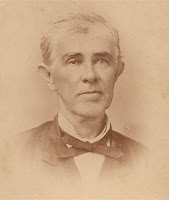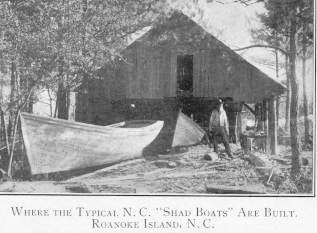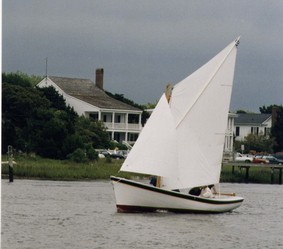 |
Dr. James Manney House
| |

Nancy Leecraft Manney (c.1820‒1886) was born in Beaufort in the "Dr. James Manney House circa 1812" on Craven Street—one of nine children of James Manney and Maria Frederica Lente.
Besides tending the sick in Beaufort and at Fort Macon, Dr. Manney was an entrepreneur and a prolific letter writer. President James Monroe appointed Dr. Manney as collector of customs. In the late 1820s, Manney competed with Otway Burns in supplying brick for the building of Fort Macon.
In a 1842/43 session of the North Carolina General Assembly, Dr. Manney was one of eleven men appointed as trustees for a new school—Beaufort Male and Female Academy.*
Soon after, Charles Grafton Wilberton French (1820‒1891), a recent graduate of Brown University, came to Beaufort to teach at the school. He soon met and was smitten by Dr. Manney’s daughter Nancy.
In November 1844, Charles decided it was time to leave Beaufort to continue his law studies. Nancy promised Charles she would wait for him, and Charles promised to return for her.
Dr. Manney, however, not in favor of the romance between Nancy and Charles, contacted his son-in-law Postmaster William Coale Bell (1807-1850) and made an agreement with him to hold any letters between Nancy or Charles.
Charles French returned to his hometown of Berkley, Massachusetts, where he studied with several prominent lawyers from 1845 through 1848. In December 1848 he was accepted into the Massachusetts Bar and began practice in Dedham, Massachusetts.
 |
Bell House circa 1830 - Except for a few
sash, all exterior fabric is replacement;
front porch was added after 1885. |
Postmaster William Coale Bell served from December 14, 1841 until his death on December 5, 1850. Bell’s wife, Mariah Alida Manney (Nancy’s sister), was appointed to replace her husband and served until December 1853. At that time, "the coming of the mail was the chief event of the day, and notice was given of its arrival by a horn blown by the stage driver as he came through town; when he arrived at the ‘post office’ on the southwest corner of Ann and Turner Streets, the town was assembled to meet him"—Amy Muse. With W.C. Bell as postmaster, the “post office” was located in his home, inherited from Elizabeth Bell, widow of William Coale Bell Sr. (The house was moved to 115 Ann about 1990.)
Postmaster Bell continued to hold letters between Nancy and Charles, perhaps storing them in a locked box. Since mail service in those days was unpredictable, Nancy and Charles may have not been concerned—until time went by with no communication.
 |
| Manney family on 1850 Beaufort Census |
After no response from his letters to Nancy, in 1851 Charles traveled to California, lived in Placer County, but moved to Sacramento in 1854. He married widow Abby Ann Haskell in 1866, practiced law for many years and also served in the state legislature.
 |
| 1860 New Bern Census |
Nancy's father died in 1852; her mother in 1864. By the 1860 census, 39-year-old Nancy was recorded in New Bern, living with her sister Mary L. Manney Emery. At the time, their widowed mother was living with daughter Frances Vail, wife of Durant H.L. Bell.
 |
| 1870 New Bern Census |
On the 1870 census, Nancy was still in New Bern, then with sister Julia (wife of shipbuilder James Howard) and family, who were in the household of a lumber dealer Amos Wade.
In 1875 President Grant appointed Charles French to chief
justice of the Supreme Court in the territory of Arizona. His wife Abby
Ann Haskell died of cancer in 1879. In 1880 French was reappointed by
President Hayes to a 2nd term as chief justice and assigned to town of Prescott; he established a law practice there in 1885.
Between 1885 and 1886, Charles sent 11 letters to Nancy from Prescott, Arizona, and Washington, D.C., beginning July 1885. Below are a few excerpts from these, donated by Nancy's great-grandniece Mary Elizabeth Strickland Guggenheimer (Manuscripts Collection at the Huntington Library in San Marino, CA).
On April 28, 1885, Charles sent a letter from Prescott to the Beaufort postmaster (then John Forlaw):
Will you be so kind as to inform me if Nancy LeCroft Manney daughter of Dr. Manney of Beaufort is still living – if not what members of the Dr’s family yet survive. I am a friend of the family and wish much to learn something of them especially of the daughter Nancy. Please do not fail to answer as I feel a deep interest in this matter.
 |
| Charles G.W. French |
Although Charles expected a response from the postmaster, he MAY have received a response from Nancy instead.
There are no letters from Nancy in the Huntington Library collection except for an 1886 note from Nancy inquiring about a
trunk, and a photocopy of the 1886 marriage application for Charles and Nancy.
In the first letter to Nancy, July 1885, Charles writes of the death of his wife (Dec. 1879) and that "she knew all about my relations to yourself, long before her marriage to me."
On September 5, 1885 Charles wrote:
When I left Beaufort I was convinced of your regard but I did not know
how your family regarded the matter. I enclose in this letter a little
ring of shining hair which has been my cherished treasure through life
and which I mean shall rest upon my heart in my grave. It has been
sacredly and safely preserved by me through all my wonderings… After the
reception of your letters received by me just prior to my marriage, I
never ceased to reproach myself for not having gone to Beaufort and
visited with you in person. You must not blame the deceased Post-Master
too much.
In October 1885 Charles wrote that he wanted to come to Beaufort so that "there should be no possibility of another mistake," and by March 1886 they had become engaged and Charles wrote that "all that I am, all that I have, and all I hope for in this life, I am ready now to devote to you." According to the Huntington Library, enclosed with one letter is a photograph of French dated 1870 (photograph not online).
Also included with the correspondence is a note from Nancy inquiring about a trunk (1886); and a photocopy of a marriage application for Charles and Nancy (1886).
So... "Just prior to" his 18 Feb 1866 marriage to Abby Ann Haskell in
Folsom, CA, Charles received "Nancy's letters" and learned of Postmaster Bell's interception of their letters in the mid- to late 1840s. Were these more recent letters from Nancy OR letters held by Postmaster Bell, OR more likely BOTH? Charles must have received a letter of explanation from Nancy, i.e., "must not blame the deceased Post-Master." The "held" letters, sent to Charles in late 1865, after the Union occupation of Beaufort, were likely sent by then postmaster Joseph Davis. Of note - legend has surmised the letters were turned over to Nancy shortly before Postmaster Bell's death in 1850; this is debunked by the fact that Charles did not receive Nancy's letters until 16 years later.
 After almost a year of correspondence, Charles returned to Beaufort and married Nancy on April 29, 1886—almost 42 years since Charles had left Beaufort.
After almost a year of correspondence, Charles returned to Beaufort and married Nancy on April 29, 1886—almost 42 years since Charles had left Beaufort.
The ceremony likely took place in brother James Lente Manney’s home at 305 Ann Street (built by William Leecraft about 1853). J.W. Jones minister; witnesses, James Lente Manney (1827‒1889), Sidney Whitehurst Styron Manney (1845‒1912, James’ second wife) and Julia A. Howard (1831‒1888, Nancy’s youngest sister).
 Charles made a brief trip to Washington, DC to find a home for his bride. Unfortunately, less than two months after the marriage Nancy died from consumption June 14, 1886. Nancy Leecraft Manney French was buried in the Manney family plot with her brother, Dr. James Lente Manney and their parents in the Old Burying Ground on Ann Street, not far from the James Manney House.
Charles made a brief trip to Washington, DC to find a home for his bride. Unfortunately, less than two months after the marriage Nancy died from consumption June 14, 1886. Nancy Leecraft Manney French was buried in the Manney family plot with her brother, Dr. James Lente Manney and their parents in the Old Burying Ground on Ann Street, not far from the James Manney House.
Charles French returned to Washington, DC, sold most of his property in Prescott, and returned to Sacramento. He died a few years later on August 13, 1891, on a trip to San Francisco, and was buried in the Old City Cemetery in Sacramento, in the family plot of his first wife.
SUMMARY NOTES:
1. LETTERS – Intercepted letters were likely kept in a locked box by postmaster Wm. C. Bell – the custody passed on to following postmasters along with other post office paraphernalia, unquestioned until postmaster Joseph Davis (tenure 1862‒1872).
2. NANCY’S LETTERS – “Held” letters from Nancy to Charles were likely forwarded to Charles by postmaster Joseph Davis in late 1865 (after Union occupation 1862-1865 during which time a locked box could have been forced opened/inspected by Union officers or soldiers). Though Charles didn’t reply due to impending marriage, these letters were surely saved by Charles - likely discarded after his death.
3. CHARLES’ LETTERS – What happened to Charles’ letters to Nancy intercepted by postmaster Bell? In late 1865, did postmaster Davis give the letters to Nancy’s mother, or send them to Nancy in New Bern? ONLY 11 letters written between 1885 and 1886 were saved by Nancy and passed down through family – donated to Huntington Library by Nancy’s great-grand niece in 1982.
▪ C.G.W. French letters to Nancy are held in the Rare Manuscripts Collection at the Huntington Library in San Marino, CA. They were donated to the library in December, 1982 by Mrs. Max Guggenheimer — Mary Elizabeth Strickland, 1st great grand niece of Nancy Leecraft Manney.
▪ Special thanks to Jim Pool for his research.
▪ Image of Charles French scanned from Beaufort's Old Burying Ground by Diane Hardy, Mamre Wilson, and Marilyn Collins.
▪ Mary Warshaw painting of the Manney House, inspired by an early 1900's postcard.
*
PRIVATE ACTS OF THE STATE OF NORTH-CAROLINA, PASSED BY THE GENERAL
ASSEMBLY, At their Session which commenced on Monday the twenty-first of
November, one thousand eight hundred and forty two, and ended on
Saturday the twenty-eight of January, one thousand eight hundred and
forty-three. An Act to incorporate the Beaufort Male and Female Academy
in the town of Beaufort hereby enacted by the authority of the same,
That Asa Canaday, Malachi B. Roberson, John F. Jones, Marcus C. Thomas,
Benjamin L. Perry, Isaac Ramsey, Benjamin Lecraft, William J. Potter,
Thomas Duncan, James Ward and James Manney, of the county of Carteret,
and their successors, be, and they are hereby constituted a body politic
and corporate, to be known and distinguished by the name and style of
the Trustees of the Beaufort Male and Female Academy. (Laws of the State
of NC, Passed by the General Assembly, at the Session of
1842-1843, Raleigh, Thomas J. Lemay, Printer, 1843, pp. 121-123)
 Robert Withers Chadwick (1826–1884) was born January 30, 1826 near Beaufort in Straits, North Carolina, son of Gayer Chadwick and Caroline Hellen. Gayer Chadwick was the son of Barnabas Chadwick and Mary Polly Walpoole. Barnabas Chadwick’s grandfather, Samuel Chadwick, the whaler, came to the Core Sound area from Cape Cod in 1726. On November 14, 1854, Robert Withers Chadwick married Mary Elizabeth Potter (1832–1897), who was born in Beaufort to William Jackson Potter and Elizabeth Harris Davis.
Robert Withers Chadwick (1826–1884) was born January 30, 1826 near Beaufort in Straits, North Carolina, son of Gayer Chadwick and Caroline Hellen. Gayer Chadwick was the son of Barnabas Chadwick and Mary Polly Walpoole. Barnabas Chadwick’s grandfather, Samuel Chadwick, the whaler, came to the Core Sound area from Cape Cod in 1726. On November 14, 1854, Robert Withers Chadwick married Mary Elizabeth Potter (1832–1897), who was born in Beaufort to William Jackson Potter and Elizabeth Harris Davis.
 This Greek revival style home was built with front porch pediments centered over three bays. Originally it was a “half-house,” consisting of a hall on the west side with four rooms on the east side-two upstairs and two downstairs.
This Greek revival style home was built with front porch pediments centered over three bays. Originally it was a “half-house,” consisting of a hall on the west side with four rooms on the east side-two upstairs and two downstairs.




















